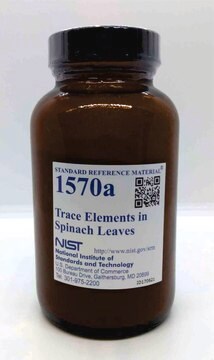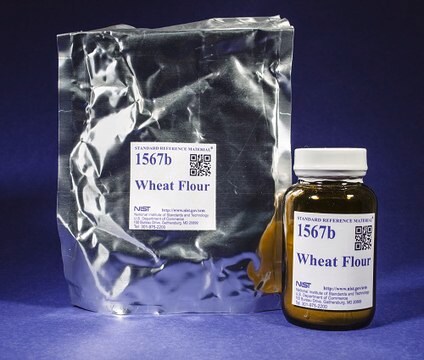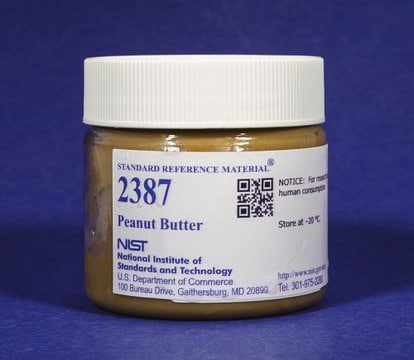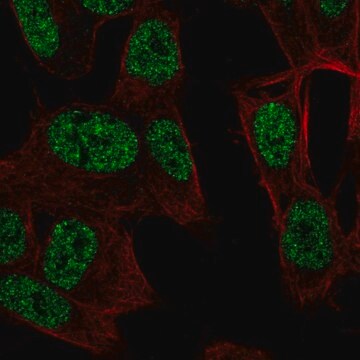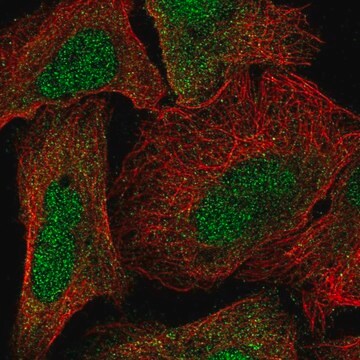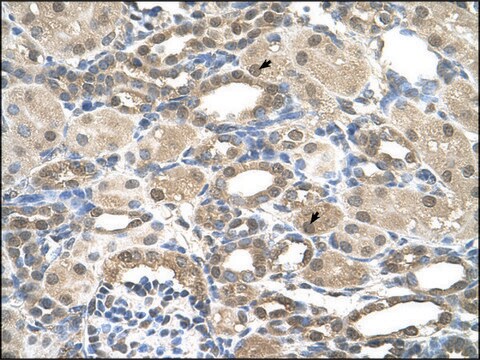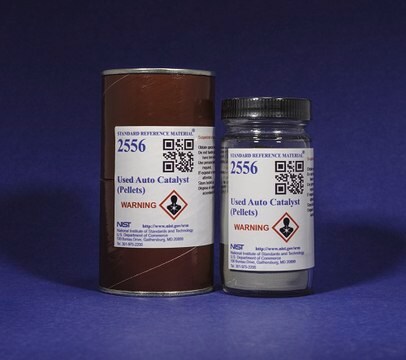おすすめの製品
関連するカテゴリー
アプリケーション
Tomato leaves has been used as a standard reference material
- in evaluating the cloud-point extraction methodology for copper and nickel determination in food samples
- for determining the precision of energy dispersive X-ray fluorescence spectrometry (EDXRF) method for nutrient analysis
- in evaluating the accuracy of high resolution continuum source flame molecular absorption spectrometry (HR-CS-FMAS) for determination of sulfur in food
- for evaluating the accuracy of thermospray flame furnace atomic absorption spectrometer (TS-FF-AAS) in cobalt determination in biological materials
生物化学的/生理学的作用
Tomato leaves is rich in calcium, magnesium, potassium and phosphorus. Other minor nutrients present in leaves includes sulfur, boron, manganese, iron, copper, zinc and molybdenum. All these nutrients constitute for the macromolecules like protein and nucleic acid. Also, helps in regulating the enzymatic activity of the plant, and for normal growth and reproduction.
その他情報
Certified for the analytes listed below. See certificate for values and more details
Kjeldahl Nitrogen, Nitrogen (Total), Phosphorus
Trace Elements: Aluminum (Al), Antimony (SB), Arsenic (As), Barium (Ba), Boron (B), Bromine (Br), Cadmium (Cd), Calcium (Ca), Cesium (Cs), Chlorine (Cl2), Chromium (Cr), Cobalt (Co), Copper (Cu), Gadolinium (Gd), Hafnium (Hf), Hydrogen (H), Iodine (I), Iron (Fe), Lanthanum (La), Magnesium (Mg), Manganese (Mn), Mercury (Hg), Molybdenum (Mo), Nickel (Ni), Potassium (K), Rubidium (Rb), Samarium (Sm), Scandium (Sc), Selenium (Se), Silver (Ag), Sodium (Na), Strontium (Sr), Sulfur (S), Thorium (Th), Uranium (U), Vanadium (V), Zinc (Zn)
Matrix Group: Fruits and Vegetables
Kjeldahl Nitrogen, Nitrogen (Total), Phosphorus
Trace Elements: Aluminum (Al), Antimony (SB), Arsenic (As), Barium (Ba), Boron (B), Bromine (Br), Cadmium (Cd), Calcium (Ca), Cesium (Cs), Chlorine (Cl2), Chromium (Cr), Cobalt (Co), Copper (Cu), Gadolinium (Gd), Hafnium (Hf), Hydrogen (H), Iodine (I), Iron (Fe), Lanthanum (La), Magnesium (Mg), Manganese (Mn), Mercury (Hg), Molybdenum (Mo), Nickel (Ni), Potassium (K), Rubidium (Rb), Samarium (Sm), Scandium (Sc), Selenium (Se), Silver (Ag), Sodium (Na), Strontium (Sr), Sulfur (S), Thorium (Th), Uranium (U), Vanadium (V), Zinc (Zn)
Matrix Group: Fruits and Vegetables
法的情報
NIST is a registered trademark of National Institute of Standards and Technology
SRM is a registered trademark of National Institute of Standards and Technology
保管分類コード
13 - Non Combustible Solids
WGK
WGK 3
適用法令
試験研究用途を考慮した関連法令を主に挙げております。化学物質以外については、一部の情報のみ提供しています。 製品を安全かつ合法的に使用することは、使用者の義務です。最新情報により修正される場合があります。WEBの反映には時間を要することがあるため、適宜SDSをご参照ください。
Jan Code
NIST1573A:
最新バージョンのいずれかを選択してください:
Determination of sulfur in food by high resolution continuum source flame molecular absorption spectrometry
Zambrzycka E and Godlewska-Zylkiewicz B
Spectrochimica Acta. Part B: Atomic Spectroscopy, 101, 234-239 (2014)
Minerals, vitamins and chlorophyll contents of fruits, stems and leaves of tomato and garden egg
Kadiri M, et al.
Pakistan Journal of Medical Sciences, 25(3), 150-154 (2015)
Acid extraction and cloud point preconcentration as sample preparation strategies for cobalt determination in biological materials by thermospray flame furnace atomic absorption spectrometry
Donati GL, et al.
Microchemical Journal, Devoted to the Application of Microtechniques in All Branches of Science, 82(2), 189-195 (2006)
Mineral nutrition of tomato
Sainju UM, et al.
Journal of food, agriculture & environment, 1(2), 176-183 (2003)
Simple procedure for nutrient analysis of coffee plant with energy dispersive X-ray fluorescence spectrometry (EDXRF)
Tezotto T, et al.
Scientia Agricola, 70(4), 263-267 (2013)
Global Trade Item Number
| カタログ番号 | GTIN |
|---|---|
| NIST1573A | 4061834120674 |
ライフサイエンス、有機合成、材料科学、クロマトグラフィー、分析など、あらゆる分野の研究に経験のあるメンバーがおります。.
製品に関するお問い合わせはこちら(テクニカルサービス)